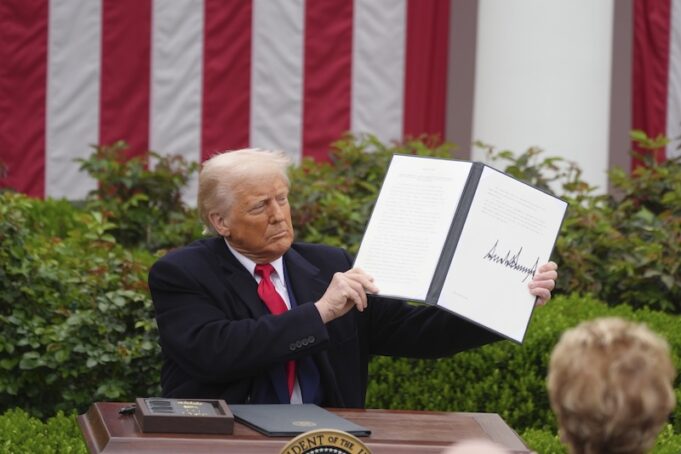The Economist magazine is not a big fan of the Trump tariffs, as recently noted in that publication. Neither is the former chief economist to Republican Senator Rob Portman, who was also lead research fellow on federal budget and spending policy at the ideologically conservative Heritage Foundation. That economist — whose views are partially excerpted below — recently observed, “[i]t’s not an issue of left-versus-right. Rather, Trump is offering policies and promises that — even on their own terms — don’t make any sense. The president’s vision cannot successfully produce fiscal responsibility or economic prosperity because nearly every statement and action contradicts each other. And ultimately, it is American families and businesses who will suffer from this fog of policy confusion.”
So, what gives?
Trump keeps saying, on the one hand, that the tariffs he is imposing will “on shore” manufacturing back to America. But this requires consistent tariffs that last for years. Why? “No entrepreneur will undertake an expensive, five-year project to build a new factory that is needed to last 50 years if the underlying trade economics are changing monthly or even weekly. Tariff, tax and regulatory policies may be helpful or hurtful, but they at least must be predictable.”
Trump’s Commerce Secretary has said the tariffs are for the long-term. Trump’s senior trade counselor has said they are, too. As has Trump.
Until they aren’t. When Trump “paused” most of the tariffs and exempted China from others in the face of a market meltdown, Trump’s press secretary implied that many of them were always intended to be nothing more than a short-term negotiating tactic to force other nations to the bargaining table. A la the “Art of the Deal.” Although this particular deal has unleashed a multi-trillion-dollar global economic meltdown that will produce no meaningful on-shoring of jobs to the U.S.
Simply stated, “Trump’s constant fiddling with the tariff dials and his claims that they are merely a short-term negotiating tactic undermine any hope of building new factories in America.”
Well, if not jobs, what about improving our fiscal health through added tariff revenue? We have been told – and told again – by Trump that these on again off again long-term tariffs that last three days will raise enough revenue to offset the deficit and, possibly, eliminate income taxes for all Americans.
Really?
Tariffs raise the price of imports, which simultaneously reduces demand for (the now more expensive) goods being imported. Currently, those imports are worth $3.2 trillion. It is “mathematically impossible” for even long-term tariffs on all of those goods to replace $2.6 trillion of annual federal income taxes. Because no tariff rate could raise that much money after accounting for the corresponding reduction in import demand.
Assume, for example, an average tariff rate of 20% that actually sticks for a year, and not just three days. That could raise up to $640 billion in tariff revenue, but “the decline in import demand and the slowdown in broader economic activity would drastically reduce those revenues, while more bailouts of export-hammered industries like agriculture would likely consume most remaining revenues.” Meaning that “[a]ny deficit reduction would be marginal and not worth the economic chaos.”
Predictably, the inability to add 2+2 on tariffs carries forward into Trump’s “broader, and equally contradictory, budget promises.” Trump says he will balance the federal budget without increasing taxes.
Except since tariffs are a revenue dead-end, “eliminating the $1.87 trillion budget deficit would require cutting 27 percent of the $7 trillion federal budget. Yet Trump has already [taken] . . . 66 percent of the budget . . . off the table (or 75 percent if we include Medicaid, which Trump occasionally promises to spare from the budget ax).”
Under those constraints, balancing the budget means eliminating virtually “every remaining federal expenditure, including border security, infrastructure, federal courts, U.S. embassies, federal prisons, all health research, national parks, unemployment benefits, disaster aid and disability benefits. Even if the president demanded every one of those cuts, not even a tea party Congress could or would pass them.”
Properly understood, instead of balancing the budget Trump’s tax cuts are much more likely to “double the national debt held by the public from $30 trillion today to approximately $60 trillion within a decade” — rendering his balanced budget promise “mathematically nonsensical” drivel resting on empty gimmicks.
Like this one: the Republican Congress now parrots (in unison) that the $4 trillion price tag of extending Trump’s tax cuts forever has “zero impact on budget deficits.” Why? Since “the tax cuts already reflect the ‘current policy’ until the end of this year . . . renewing their cost forever is ‘free.’” Which is, of course, “fiscal nonsense. It’s like a debt-ridden family buying a $100,000 sports car one year and then asserting that buying another next year is not costly because their annual spending level is not rising.”
Then there is DOGE. Musk promised to quickly save $2 trillion, before lowering it to $1 trillion and now claims to have saved $150 billion. Which would still be real money, except that it isn’t. Less than $5 billion of that sum — being less than 0.1% of federal spending — is verifiable. “The rest of the claimed savings are either not backed up with specific data or based on mathematical errors, triple-counting the same savings and theoretical ‘savings’ of funds that were never going to be spent. Ultimately, DOGE is government spending-cut theater that targets MAGA cultural totems such as DEI contracts, media subscriptions, federal employees and foreign aid that collectively save little money. Which is why total federal spending this year currently exceeds the level of spending during the same period last year.”
“In fact, DOGE is likely to ultimately expand budget deficits.” This follows because “many of the laid off federal employees are currently collecting salaries and benefits while courts weigh the legality of their job cuts” and “drastic layoffs of IRS tax enforcement employees are expected to encourage tax evasion and cost the federal government hundreds of billions of dollars in revenue.”
How so? Taxes are collected by the IRS. Since January of this year the IRS has had five different directors, cut 1/3 of its personnel, and stopped modernizing its antiquated computer system. All in the name of government efficiency.
There are ways to make things better in this country. Hard rational decisions based on facts and common sense would be a start. This is the opposite of that. We will now all pay it for in many ways, including less services and higher prices across the board. Call it a consumption tax. Call it a diminished standard of living. Call it what you will. It means less money for you to live your life, for no other reason than Trump’s unwillingness to allow for the possibility that he is (ever) wrong. About anything.
On that score, it bears emphasis here that Trump and Trump alone is doing this. Because he purposefully selected a cabinet of clowns to assure that he is unimpeded when he calls the shots, driven by his gut instincts.
How good are those instincts? Trump entities have declared bankruptcy six times. The notion that he lacks a strong grasp of finance makes intuitive sense to me. As does the maxim that in the land of the blind, the one-eyed man is king.
Much less clear is when, and whether, we will regain our sight.
Andrew Leven, a former federal prosecutor, is an attorney in private practice. He lives in Riverhead.
Editor’s note: RiverheadLOCAL welcomes guest columns from anyone who wants to submit a viewpoint on any topic. The opinions expressed in guest columns are those of the author and do not reflect the point of view of RiverheadLOCAL’s publishers. Please be sure to include your email address and daytime phone number with your submission. Submit your opinion here.
The survival of local journalism depends on your support.
We are a small family-owned operation. You rely on us to stay informed, and we depend on you to make our work possible. Just a few dollars can help us continue to bring this important service to our community.
Support RiverheadLOCAL today.


































